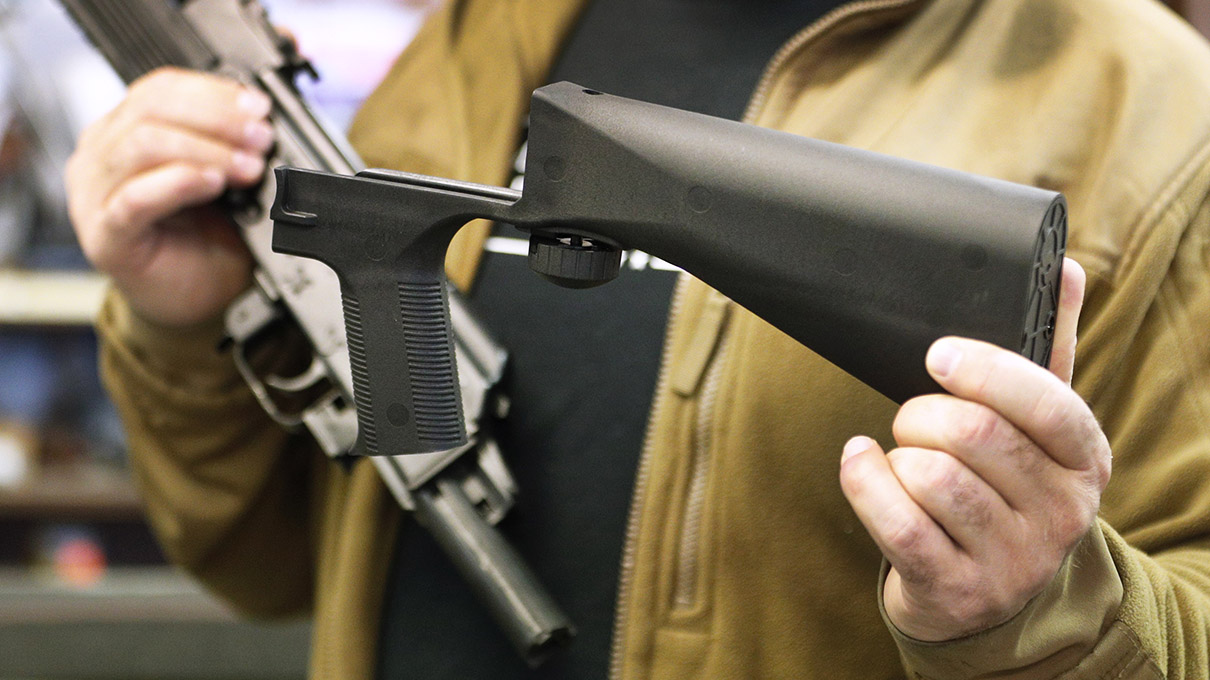

Finance
How Do Bump Stocks Work
Published: January 17, 2024
Discover the mechanics behind bump stocks and their impact on finance. Gain insight into the workings of these controversial firearm accessories.
(Many of the links in this article redirect to a specific reviewed product. Your purchase of these products through affiliate links helps to generate commission for LiveWell, at no extra cost. Learn more)
Table of Contents
Introduction
In recent years, the topic of bump stocks has captured the attention of both firearms enthusiasts and those concerned with public safety. These devices, which can be attached to a semi-automatic rifle, have sparked intense debate and controversy. Bump stocks have been at the center of attention due to their association with the rapid firing of firearms, raising questions about their legality, functionality, and potential risks.
A bump stock is a device designed to increase the rate of fire of a semi-automatic rifle by harnessing the weapon’s recoil to “bump” the trigger against the shooter’s stationary finger. This enables the firearm to discharge multiple rounds rapidly, mimicking the effect of a fully automatic weapon. While bump stocks have been available on the market for several years, they gained significant attention and scrutiny following the mass shooting incident in Las Vegas in 2017, where the shooter used firearms equipped with bump stocks.
The legal status of bump stocks varies by jurisdiction. In some countries, they are banned outright, while in others, possession and use may be regulated or unrestricted. The controversy surrounding bump stocks primarily stems from concerns over public safety and the potential misuse of these devices to inflict harm. Proponents argue that bump stocks are a form of firearms accessory that can enhance recreational shooting experiences, while opponents argue that they pose a significant risk and should be strictly regulated or banned altogether.
This article aims to provide a comprehensive understanding of how bump stocks work, the legal status and controversies surrounding them, the mechanics behind their operation, and the safety concerns associated with their use. By exploring these aspects, readers can form a well-informed opinion about the role of bump stocks in firearm culture and their implications for public safety.
Definition of Bump Stocks
A bump stock is a firearm accessory that is designed to increase the rate of fire of a semi-automatic rifle. It accomplishes this by utilizing the recoil generated by each shot fired, which in turn allows the shooter to maintain a continuous firing motion without manually pulling the trigger for each shot. Bump stocks are typically made of plastic or other lightweight materials and can be attached to the rear of the rifle, replacing the original stock. They feature a sliding mechanism that allows the firearm to move back and forth within the stock, facilitating the “bumping” action.
When the shooter fires the rifle equipped with a bump stock, the natural rearward motion of the rifle’s recoil causes the stock to slide forward, resetting the trigger against the shooter’s stationary finger. As the shooter maintains forward pressure on the rifle, the recoil causes it to move back into the shooter’s shoulder, which pulls the trigger against the stationary finger again. This repeated motion, in combination with the shooter’s forward pressure, creates a rapid cycle of trigger reset and firing, resulting in a rapid succession of shots being discharged from the firearm.
It is important to note that bump stocks do not alter the internal mechanisms of the rifle or convert it into a fully automatic weapon. Semi-automatic firearms, such as the popular AR-15, are designed to fire one round with each pull of the trigger. Bump stocks simply facilitate a technique where the shooter can achieve a higher rate of fire by taking advantage of the firearm’s natural recoil.
While bump stocks may increase the rate of fire, they do not enhance the inherent accuracy or precision of the firearm. Additionally, the sliding motion of the stock can lead to a loss of stability and control, potentially affecting the shooter’s aim and accuracy. Critics argue that bump stocks serve no legitimate purpose and are primarily used for recreational or entertainment purposes rather than practical applications.
It is worth noting that the terminology and definition of bump stocks may vary depending on different jurisdictions and firearms regulations. Some countries have specific legal definitions for bump stocks, while others may group them under broader categories such as “rate-increasing devices.” Understanding the legal definitions and restrictions pertaining to bump stocks is essential to fully grasp their status and legality in a particular jurisdiction.
Legal Status and Controversy Surrounding Bump Stocks
The legal status of bump stocks has been the subject of intense debate and controversy in many countries. Due to their association with the rapid firing of firearms, bump stocks have faced scrutiny from lawmakers and public safety advocates. Their availability and use are often considered in the context of existing firearms regulations and laws governing automatic weapons.
In some jurisdictions, bump stocks are banned outright. These countries have enacted legislation specifically prohibiting the possession, sale, and use of bump stocks. For example, in the United States, following the Las Vegas shooting in 2017, the use of bump stocks was banned by the Bureau of Alcohol, Tobacco, Firearms, and Explosives (ATF). The ATF classified bump stocks as “machine guns” under federal law, effectively making their possession illegal.
However, the legality of bump stocks continues to vary across different regions. Some places have imposed restrictions on bump stocks, such as requiring permits or registration, while others have no specific regulations in place. This inconsistency has led to debates about the need for standardized regulations to address the issue.
The controversy surrounding bump stocks revolves around public safety concerns and the potential for misuse and harm. Critics argue that bump stocks have the potential to enable individuals to carry out mass shootings with greater ease and devastation. They argue that the increased rate of fire provided by bump stocks allows shooters to discharge a large number of rounds in a short period, making it difficult for potential victims to escape or for law enforcement to respond effectively.
Proponents of bump stocks, on the other hand, contend that the devices are simply accessories that enhance recreational shooting experiences. They argue that bump stocks can provide a unique and thrilling experience for gun enthusiasts, without posing any significant risk when used responsibly.
Overall, the legal status and controversy surrounding bump stocks highlight the ongoing debate between Second Amendment rights and public safety concerns. Balancing these factors is essential for lawmakers as they consider the appropriate regulations associated with bump stocks, taking into account the potential risks and benefits that these devices may pose to society.
Mechanics of Bump Stocks
To understand how bump stocks work, it’s important to delve into their mechanical design and functionality. Bump stocks are typically made of lightweight materials such as plastic or polymer. They are designed to replace the original stock of a semi-automatic rifle and feature a sliding mechanism.
The primary component of a bump stock is the stock itself, which attaches to the rear of the rifle. This stock allows for movement back and forth, facilitating the “bumping” action. The innovative design of the bump stock enables it to utilize the rifle’s recoil to reset the trigger against the shooter’s stationary finger.
At the core of the bump stock is a mechanism that incorporates a sliding block or a fulcrum point. When the shooter fires the rifle, the recoil force causes the entire rifle, including the bump stock, to move back within the shooter’s shoulder. As the rifle moves back, the shooter’s stationary finger remains in contact with the trigger.
As the recoil motion of the rifle ends, the bump stock starts to move forward, driven by a spring or the pressure of the shooter’s forward hand. This forward movement causes the trigger to reset against the shooter’s stationary finger, positioning it for another shot.
Once the trigger is reset, the shooter’s forward hand pushes the rifle forward into the stationary finger. The pressure exerted on the rifle against the trigger causes the next round to be discharged. This process repeats as long as the shooter maintains forward pressure on the rifle.
It’s important to note that the “bumping” action generated by a bump stock does not alter the fundamental firing mechanism of the rifle. The trigger is still being actuated by the shooter’s finger for each shot, with the bump stock helping to reset the trigger quickly. In essence, the bump stock allows for a continuous and rapid cycle of trigger reset and firing, resulting in a higher rate of fire compared to manually pulling the trigger for each shot.
While bump stocks have been primarily associated with rifles, there are variants designed for handguns as well. The mechanics of handgun bump stocks generally follow a similar principle of utilizing recoil and trigger reset.
The mechanics of bump stocks underscore the key distinction between semi-automatic rifles with bump stocks and fully automatic firearms. Unlike fully automatic weapons, which discharge rounds continuously as long as the trigger is held down, bump stocks rely on the shooter’s manipulation of the firearm and the trigger reset to achieve rapid fire.
Understanding the mechanics of bump stocks allows us to have a deeper appreciation of how these devices facilitate increased rates of fire, even though they do not fundamentally alter the internal mechanisms of the rifle.
How Bump Stocks Facilitate Rapid Fire
Bump stocks have gained attention and controversy due to their ability to facilitate rapid fire with semi-automatic firearms. Understanding how bump stocks enable this increased rate of fire requires examining the specific techniques employed by shooters utilizing these devices.
When a shooter uses a bump stock-equipped firearm, their trigger finger remains stationary against the trigger. The shooter’s other hand applies forward pressure on the rifle, while the recoil generated by each shot causes the firearm to move back within the shoulder and reset the trigger against the stationary finger.
As the shooter maintains forward pressure, the rifle moves forward again, resetting the trigger once more, allowing for subsequent shots. This cycle of trigger reset and firing is repeated as long as the shooter maintains the forward pressure on the rifle.
The bump stock essentially acts as a facilitating mechanism, allowing the shooter to achieve this continuous cycle of trigger reset and discharge without manually releasing and re-engaging the trigger for each shot. By harnessing the natural recoil of the firearm and exploiting the mechanical design of the bump stock, shooters can achieve a higher rate of fire compared to traditional semi-automatic shooting techniques.
It’s important to note that achieving rapid fire with a bump stock requires a specific shooting technique and a level of practice and skill. The shooter must apply consistent forward pressure and maintain proper control over the firearm to ensure the bump stock functions as intended.
The rate of fire achieved with a bump stock can vary depending on several factors, including the specific bump stock design, the shooter’s proficiency, and the type of firearm used. With proper technique, experienced shooters can achieve rates of fire approaching that of fully automatic firearms, but the overall accuracy and control may be compromised due to the nature of the rapid firing technique.
While bump stocks allow for rapid fire, it’s worth noting that shooters are still required to follow all safety procedures and regulations regarding firearms. The principles of firearm safety, including proper handling, proper storage, and adherence to local laws, remain crucial when using any firearm, including those equipped with bump stocks.
Understanding the mechanics and techniques behind how bump stocks facilitate rapid fire sheds light on the functionality and implications of these devices. The ability to discharge multiple rounds rapidly has raised concerns about the potential for increased casualties in mass shooting incidents, leading to debates regarding their legality and appropriate regulations.
Safety Concerns and Issues with Bump Stocks
Bump stocks have raised significant safety concerns and have been the subject of intense scrutiny. Critics argue that these devices present a range of issues that compromise firearm safety and pose potential risks to both the user and the public.
One of the main safety concerns with bump stocks is the potential loss of control and stability. The sliding motion created by the bump stock can introduce instability in the shooter’s grip on the firearm, affecting accuracy and increasing the likelihood of unintended movements. This can make it difficult for shooters to maintain proper control over the firearm during rapid fire, potentially leading to diminished accuracy and an increased risk of misfires or unintentional discharge.
Additionally, the rapid firing facilitated by bump stocks can lead to increased heat generation within the firearm. Overheating can cause malfunctions, durability issues, or even catastrophic failures, which can be dangerous for the shooter and bystanders. The prolonged use of bump stocks can also accelerate the wear and tear on the firearm, potentially affecting its overall reliability and safety.
Another critical concern associated with bump stocks is the potential for unintentional or accidental discharge. Given the high rate of fire and the modified trigger reset action, shooter-induced errors or mechanical failures can increase the risk of unintentional discharges. This becomes a significant concern in situations where individuals may not be adequately trained or familiar with the unique characteristics of bump stocks.
The use of bump stocks also poses particular challenges from a safety standpoint when it comes to reloading and clearing malfunctions. The rapid succession of shots and the unique firing technique can complicate these standard firearm procedures, potentially leading to delays or errors in critical situations.
Furthermore, the increased rate of fire facilitated by bump stocks raises concerns about the potential for increased casualties in mass shooting incidents. The ability to discharge rounds rapidly can make it more challenging for potential victims to escape or for law enforcement to intervene effectively.
It’s important to note that these safety concerns are specific to the use of bump stocks and the unique techniques they require. They do not apply to standard semi-automatic firearms or to manual trigger control techniques. Proper training, safety protocols, and responsible firearm ownership are crucial in mitigating these concerns and preventing accidents or misuse.
Given these safety concerns, and in light of incidents involving bump stocks, many countries have regulated or banned their use. Some have taken decisive legislative actions to restrict or eliminate the possession and sale of bump stocks to address the potential risks associated with these devices.
Past Incidents Involving Bump Stocks
Bump stocks gained widespread attention and scrutiny following their involvement in several high-profile incidents. These tragic events highlighted the potential for bump stocks to be used to devastating effect in mass shooting incidents.
One of the most notable incidents involving bump stocks occurred in Las Vegas in October 2017. A gunman used bump stock-equipped rifles to carry out a mass shooting at a music festival, resulting in the deaths of 58 people and injuring hundreds more. The rapid rate of fire made possible by the bump stocks contributed to the unprecedented scale of the tragedy and prompted calls for stricter regulations on these devices.
The Las Vegas incident was a turning point in the debate surrounding bump stocks and led to an increased focus on their potential misuse and the need for legislative action. Lawmakers, public safety advocates, and the general public recognized the significant role that bump stocks played in the high casualty count and the distinctive firing pattern observed during the attack.
Following the Las Vegas shooting, there were a number of incidents involving bump stocks that further intensified the concerns surrounding their use. While the majority of these incidents occurred in the United States due to the greater availability of bump stocks, there have been reports of similar incidents in other countries as well.
These incidents have highlighted the fact that bump stocks can effectively mimic the firing speed of fully automatic weapons, leading to significant casualties and making it challenging for law enforcement to respond and neutralize the threat. The rapid discharge of rounds facilitated by bump stocks in these incidents underscores the potential danger they pose when misused or placed in the wrong hands.
The past incidents involving bump stocks were a wake-up call for lawmakers and the public, prompting a reevaluation of the regulations surrounding these devices. Public outcry and the recognition of the significant risks associated with bump stocks led to legislative actions aimed at tightening restrictions, banning their possession and use, or implementing stricter controls to prevent their misuse.
It is important to remember that these incidents represent extreme and devastating events. However, they serve as critical reminders of the potential impact of bump stocks and the pressing need for appropriate regulations to address the risks they present.
Legislative Actions Taken against Bump Stocks
The use of bump stocks in high-profile incidents prompted swift legislative responses in various jurisdictions. Governments and lawmakers recognized the need to address the potential risks associated with these devices and took actions to regulate or outright ban them.
One notable legislative action occurred in the United States. In the aftermath of the Las Vegas shooting in 2017, where bump stocks were used to devastating effect, the Bureau of Alcohol, Tobacco, Firearms, and Explosives (ATF) classified bump stocks as “machine guns” under federal law. This classification effectively made the possession, sale, and use of bump stocks illegal in the United States.
Additionally, some individual states in the United States have implemented their own legislation regarding bump stocks. Several states, including California, Massachusetts, and New Jersey, have banned bump stocks, while others have imposed restrictions or requirements for their possession and use.
Internationally, countries have taken various approaches towards regulating bump stocks. Some nations have implemented outright bans on these devices. For example, countries such as Australia, New Zealand, and Canada have prohibited the possession and sale of bump stocks.
Other countries have taken a more nuanced approach. For instance, in Germany, bump stocks are generally not permitted, but exceptions can be made for certified sports shooters under certain conditions. In the United Kingdom, bump stocks are classified as “bump-fire stocks” and are regulated as prohibited items under firearms legislation.
The legislative actions against bump stocks reflect a commitment to addressing the safety concerns associated with these devices while ensuring compliance with firearms regulations. The aim is to strike a balance between upholding individual rights and public safety.
However, it is worth noting that the effectiveness of legislation alone in curbing the use of bump stocks is dependent on factors such as enforcement, education, and public awareness. Law enforcement agencies play a vital role in enforcing the laws surrounding bump stocks, and public education campaigns can help increase awareness about the potential risks associated with these devices.
It is important for lawmakers to continuously monitor and reassess the effectiveness of their legislative measures in regulating bump stocks. As technology advances, there may be a need to adapt regulations and ensure they remain relevant and effective in addressing emerging firearm accessories that can mimic automatic fire.
The legislative actions taken against bump stocks demonstrate a commitment to public safety and a recognition of the potential risks posed by these devices. As the conversation surrounding firearms regulation continues, it is likely that further measures will be considered and implemented to ensure the responsible and safe use of firearms.
Conclusion
Bump stocks have undeniably sparked intense debates and controversies within the realm of firearm regulation and public safety. These accessories, designed to increase the rate of fire of semi-automatic rifles, have raised significant concerns and have been involved in tragic incidents.
Throughout this article, we have explored various facets of bump stocks, ranging from their definition and mechanics to the legal status and controversies surrounding them. We have also examined the safety concerns associated with bump stocks, as well as past incidents that have underscored the need for regulatory actions.
The use of bump stocks has prompted legislative responses in many countries, with bans, restrictions, and classification changes being implemented to address the risks associated with these devices. The goal is to strike a balance between upholding personal liberties and ensuring public safety.
It is crucial to recognize that responsible firearm ownership, proper training, and adherence to safety protocols are paramount with or without the presence of bump stocks. The focus should be on encouraging responsible behavior and education regarding firearms, as well as promoting the enforcement of existing regulations to prevent misuse.
As technology continues to evolve, it is crucial for lawmakers, law enforcement agencies, and the broader society to remain vigilant in identifying emerging firearm accessories that may pose risks similar to bump stocks. Continued discussions, collaborations, and assessments are essential to adapt regulations and ensure that they effectively address the evolving landscape of firearms and accessories.
Ultimately, the discussion surrounding bump stocks should serve as a catalyst for broader conversations about firearms, public safety, and the well-being of communities. By engaging in an open and constructive dialogue, we can strive to find reasonable and effective solutions that balance individual rights with public safety concerns.
It is important to approach this discourse with the goal of fostering a safer society while respecting the rights and interests of all stakeholders. By doing so, we can work towards a future where responsible firearm ownership and public safety go hand in hand.














